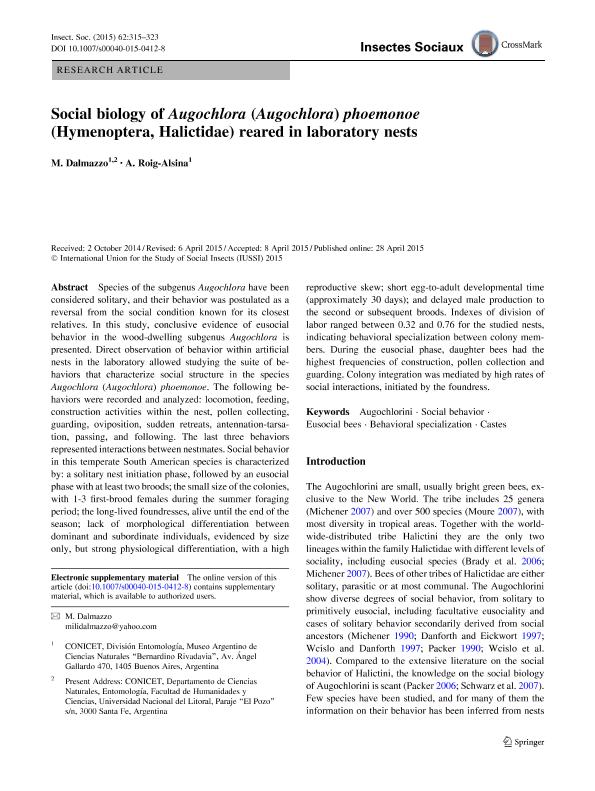Mostrar el registro sencillo del ítem
dc.contributor.author
Dalmazzo, Maria de Los Milagros

dc.contributor.author
Roig Alsina, Arturo Hernan

dc.date.available
2018-05-28T21:21:33Z
dc.date.issued
2015-04
dc.identifier.citation
Dalmazzo, Maria de Los Milagros; Roig Alsina, Arturo Hernan; Social biology of Augochlora (Augochlora) phoemonoe (Hymenoptera, Halictidae) reared in laboratory nests; Birkhauser Verlag Ag; Insectes Sociaux; 62; 3; 4-2015; 315-323
dc.identifier.issn
0020-1812
dc.identifier.uri
http://hdl.handle.net/11336/46365
dc.description.abstract
Species of the subgenus Augochlora have been considered solitary, and their behavior was postulated as a reversal from the social condition known for its closest relatives. In this study conclusive evidence of eusocial behavior in the wood-dwelling subgenus Augochlora is presented. Direct observation of behavior within artificial nests in the laboratory allowed to study the suite of behaviors that characterize social structure in the species Augochlora (Augochlora) phoemonoe. The following behaviors were recorded and analyzed: locomotion, feeding, construction activities within the nest, pollen collecting, guarding, oviposition, sudden retreats, antennation-tarsation, passing, and following. The last three behaviors represented interactions between nestmates. Social behavior in this temperate South American species is characterized by: a solitary nest initiation phase, followed by an eusocial phase with at least two broods; the small size of the colonies, with 1-3 first-brood females during the summer foraging period; the long-lived foundresses, alive until the end of the season; lack of morphological differentiation between dominant and subordinate individuals, evidenced by size only, but strong physiological differentiation, with a high reproductive skew; short egg-to-adult developmental time (approximately 30 days); and delayed male production to the second or subsequent broods. Indexes of division of labor ranged between 0.32 and 0.76 for the studied nests, indicating behavioral specialization between colony members. During the eusocial phase daughter bees had the highest frequencies of construction, pollen collection and guarding. Colony integration was mediated by high rates of social interactions, initiated by the foundress.
dc.format
application/pdf
dc.language.iso
eng
dc.publisher
Birkhauser Verlag Ag

dc.rights
info:eu-repo/semantics/openAccess
dc.rights.uri
https://creativecommons.org/licenses/by-nc-sa/2.5/ar/
dc.subject
Augochlorini
dc.subject
Social Behavior
dc.subject
Eusocial Bees
dc.subject
Behavioral Specialization
dc.subject.classification
Otras Ciencias Biológicas

dc.subject.classification
Ciencias Biológicas

dc.subject.classification
CIENCIAS NATURALES Y EXACTAS

dc.title
Social biology of Augochlora (Augochlora) phoemonoe (Hymenoptera, Halictidae) reared in laboratory nests
dc.type
info:eu-repo/semantics/article
dc.type
info:ar-repo/semantics/artículo
dc.type
info:eu-repo/semantics/publishedVersion
dc.date.updated
2018-05-23T16:32:16Z
dc.identifier.eissn
1420-9098
dc.journal.volume
62
dc.journal.number
3
dc.journal.pagination
315-323
dc.journal.pais
Suiza

dc.journal.ciudad
Basilea
dc.description.fil
Fil: Dalmazzo, Maria de Los Milagros. Consejo Nacional de Investigaciones Científicas y Técnicas. Oficina de Coordinación Administrativa Parque Centenario. Museo Argentino de Ciencias Naturales "Bernardino Rivadavia"; Argentina. Universidad Nacional del Litoral. Facultad de Humanidades y Ciencias. Departamento de Ciencias Naturales. Cátedra de Entomología; Argentina
dc.description.fil
Fil: Roig Alsina, Arturo Hernan. Consejo Nacional de Investigaciones Científicas y Técnicas. Oficina de Coordinación Administrativa Parque Centenario. Museo Argentino de Ciencias Naturales "Bernardino Rivadavia"; Argentina
dc.journal.title
Insectes Sociaux

dc.relation.alternativeid
info:eu-repo/semantics/altIdentifier/doi/http://dx.doi.org/10.1007/s00040-015-0412-8
dc.relation.alternativeid
info:eu-repo/semantics/altIdentifier/url/https://link.springer.com/article/10.1007/s00040-015-0412-8
Archivos asociados
